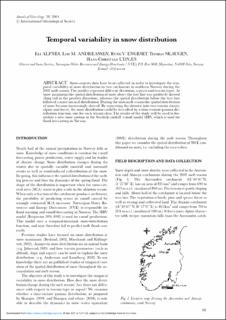| dc.description.abstract | Snow-courses data have been collected in order to investigate the temporal variability of snow distribution in two catchments in southern Norway during the 2002 melt season. The profiles represent different elevations, aspects and terrain types. At snow maximum the spatial distribution of snow above the tree line was positively skewed (long tail in the positive direction), whereas the spatial distribution below the tree line followed a more normal distribution. During the snowmelt season the spatial distribution of snow became increasingly skewed. By separating the datasets into two terrain classes, alpine and forest, the snow distribution could be described by a time-variant gamma distribution function, one for each terrain class. The results of the study will be used to formulate a new snow routine in the Swedish rainfall–runoff model HBV, which is used for flood forecasting in Norway. | en_US |
